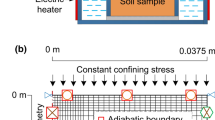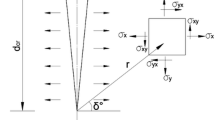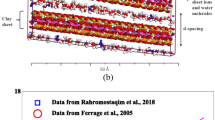Abstract
This paper presents a new finite element method (FEM) model to simulate the thermo-hydro-mechanical (THM) responses of water-saturated clay soils. The model can account for the effects of temperature variation on bound water dehydration and the corresponding thermo-poromechanical strains. The governing equations, including mass balance, momentum balance, and energy balance, are derived based on the principles of continuum mechanics for porous media. The impact of bound water dehydration on THM behavior is incorporated into the coupled THM equations. The model is equipped with an unconventional plasticity for more accurate description of elastoplastic behavior. To solve the nonlinear system of equations, a modified Newton–Raphson method is employed. The model is validated using laboratory tests on various clay soils with different geological origins, and reasonable agreement is achieved. The thermally induced contraction behavior of clay soils at a low overconsolidation ratio and thermally induced expansion behavior at a high overconsolidation ratio are well simulated. During heating, the effect of bound water dehydration on the generation of excess pore pressure in clay soils is highlighted in our numerical results.










Similar content being viewed by others
Data availability
The original data that support the findings of this study are available from the corresponding author, BL, upon request.
Abbreviations
- \(c_{{\text{s}}}\) :
-
Specific heat capacity of solid
- \(c_{{\text{f}}}\) :
-
Specific heat capacity of free water
- \(c_{{\text{b}}}\) :
-
Specific heat capacity of bound water
- \(F_{0}\) :
-
Preconsolidation pressure
- g:
-
Gravity
- H :
-
Hardening parameter
- \(h_{{\text{e}}}\) :
-
Maximum element length of the mesh
- \({\mathbf{k}}\) :
-
Intrinsic permeability
- \(\overline{N}\) :
-
Normalized outward normal of the subloading surface
- n :
-
Soil porosity
- \(n_{{\text{s}}}\) :
-
Volume fractions of the solid phase
- \(n_{{\text{f}}}\) :
-
Volume fractions of the free water phase
- \(n_{{\text{b}}}\) :
-
Volume fractions of the bound water phase
- \({\mathbf{n}}\) :
-
Outward normal direction
- \(P^{{\text{f}}}\) :
-
Pore water pressure
- \(P_{{\text{e}}}\) :
-
Local Peclet number
- \({\mathbf{q}}\) :
-
Volumetric flow rate per unites of surface area
- \(\overline{q}^{{\text{f}}}\) :
-
Water flux at the boundary
- \(\overline{q}^{{\text{T}}}\) :
-
Heat flux at the boundary
- R :
-
Similarity ratio
- \(s_{{\text{f}}}\) :
-
Degree of saturation of free water
- \(s_{{\text{b}}}\) :
-
Degree of saturation of bound water
- T :
-
Temperature
- \(T_{{{\text{Ini}}}}\) :
-
Initial temperature
- \(T_{{\text{e}}}\) :
-
Temperature of the surrounding environment
- \({\overline{\mathbf{t}}}\) :
-
Traction boundary condition
- u :
-
Material parameter
- \(v_{{\text{s}}}\) :
-
Soil particles velocity
- \(v_{{\text{f}}}\) :
-
Free water velocity
- \(w_{{\text{b}}}\) :
-
Bound water content
- \(w_{{{\text{b}},{\text{Ini}}}}\) :
-
Bound water content at the initial temperature
- \(\alpha_{{{\text{bf}}}}\) :
-
Constant that controls the conversion of bound to free water per each unit rise in temperature
- \(\beta_{{\text{s}}}\) :
-
Thermal expansion coefficient of the soil phase
- \(\beta_{{\text{f}}}\) :
-
Thermal expansion coefficient of the free water phase
- \(\beta_{{\text{b}}}\) :
-
Thermal expansion coefficient of the bound water phase
- \(\beta_{{\text{T}}}\) :
-
Equivalent thermal expansion coefficient
- \(\gamma_{t}\) :
-
Thermal softening coefficient
- \(\varepsilon\) :
-
Total strain
- \(\varepsilon^{e}\) :
-
Elastic strain
- \(\varepsilon^{p}\) :
-
Plastic strain
- \(\varepsilon^{T}\) :
-
Thermal elastic strain
- \(\kappa\) :
-
Slopes of the unloading–reloading line
- \(\lambda_{{{\text{eff}}}}\) :
-
Effective thermal conductivity
- \(\lambda_{{\text{s}}}\) :
-
Thermal conductivity of solid
- \(\lambda_{{\text{f}}}\) :
-
Thermal conductivity of free water
- \(\lambda_{{\text{b}}}\) :
-
Thermal conductivity of bound water
- \(\lambda\) :
-
Slopes of the normal consolidation line
- \(\overline{\lambda }\) :
-
Positive proportionality factor
- \(\lambda_{{\text{e}}}\) :
-
Thermal conductivity of the surrounding environment
- \(\mu_{{\text{f}}}\) :
-
Dynamic viscosity of water
- \(\rho_{{\text{s}}}\) :
-
Density of soil particles
- \(\rho_{{\text{f}}}\) :
-
Density of free water
- \(\rho_{{\text{b}}}\) :
-
Density of bound water
- \(\rho_{{{\text{eff}}}}\) :
-
Bulk density of the solid bound water–fluid mixture
- \(\left( {\rho c} \right)_{{{\text{eff}}}}\) :
-
Effective heat capacity
- \({{\varvec{\upsigma}}}\) :
-
Total Cauchy stress tensor
- \({{\varvec{\upsigma}}}^{{\mathbf{\prime }}}\) :
-
Effective Cauchy stress tensor
References
Abuel-Naga HM, Bergado DT, Bouazza A (2007) Thermally induced volume change and excess pore water pressure of soft Bangkok clay. Eng Geol 89:144–154
An M, Zhang F, Min K et al (2021) The potential for low-grade metamorphism to facilitate fault instability in a geothermal reservoir. Geophys Res Lett 48:e2021GL093552
Bekele YW, Kyokawa H, Kvarving AM et al (2017) Isogeometric analysis of THM coupled processes in ground freezing. Comput Geotech 88:129–145
Brooks AN, Hughes TJR (1982) Streamline upwind/Petrov–Galerkin formulations for convection dominated flows with particular emphasis on the incompressible Navier-Stokes equations. Comput Methods Appl Mech Eng 32:199–259
Brown KM, Ransom B (1996) Porosity corrections for smectite-rich sediments: impact on studies of compaction, fluid generation, and tectonic history. Geology 24:843–846
Brown KM, Saffer DM, Bekins BA (2001) Smectite diagenesis, pore-water freshening, and fluid flow at the toe of the Nankai wedge. Earth Planet Sci Lett 194:97–109
Cacace M, Jacquey AB (2017) Flexible parallel implicit modelling of coupled thermal-hydraulic-mechanical processes in fractured rocks. Solid Earth 8:921–941. https://doi.org/10.5194/se-8-921-2017
Cariou S, Dormieux L, Skoczylas F (2013) An original constitutive law for Callovo-Oxfordian argillite, a two-scale double-porosity material. Appl Clay Sci 80:18–30
Cekerevac C, Laloui L (2004) Experimental study of thermal effects on the mechanical behaviour of a clay. Int J Numer Anal methods. Geomech 28:209–228
Colten-Bradley VA (1987) Role of pressure in smectite dehydration—effects on geopressure and smectite-to-illite transformation. Am Assoc Pet Geol Bull 71:1414–1427
Cui YJ, Sultan N, Delage P (2000) A thermomechanical model for saturated clays. Can Geotech J 37:607–620. https://doi.org/10.1139/t99-111
Delage P, Sultan N, Cui YJ (2000) On the thermal consolidation of Boom clay. Can Geotech J 37:343–354
Diersch H-J, Kolditz O (1998) Coupled groundwater flow and transport: 2. Thermohaline and 3D convection systems. Adv Water Resour 21:401–425
Di Donna A, Charrier P, Dijkstra J et al (2022) The contribution of swelling to self-sealing of claystone studied through x-ray tomography. Phys Chem Earth, Parts A/B/C 127:103191
Di Donna A, Laloui L (2015) Response of soil subjected to thermal cyclic loading: experimental and constitutive study. Eng Geol 190:65–76. https://doi.org/10.1016/j.enggeo.2015.03.003
Galeao AC, Almeida RC, Malta SMC, Loula AFD (2004) Finite element analysis of convection dominated reaction–diffusion problems. Appl Numer Math 48:205–222
Ghasemzadeh H, Ghoreishian Amiri SA (2013) A hydro-mechanical elastoplastic model for unsaturated soils under isotropic loading conditions. Comput Geotech 51:91–100. https://doi.org/10.1016/j.compgeo.2013.02.006
Ghasemzadeh H, Sojoudi MH, Ghoreishian Amiri SA, Karami MH (2017) Elastoplastic model for hydro-mechanical behavior of unsaturated soils. Soils Found 57:371–383. https://doi.org/10.1016/j.sandf.2017.05.005
Gray WG, Miller CT (2005) Thermodynamically constrained averaging theory approach for modeling flow and transport phenomena in porous medium systems: 1 motivation and overview. Adv Water Resour 28:161–180
Hashiguchi K, Saitoh K, Okayasu T, Tsutsumi S (2002) Evaluation of typical conventional and unconventional plasticity models for prediction of softening behaviour of soils. Géotechnique 52:561–578. https://doi.org/10.1680/geot.52.8.561.38829
Hong PY, Pereira JM, Tang AM, Cui YJ (2013) On some advanced thermo-mechanical models for saturated clays. Int J Numer Anal Methods Geomech 37:2952–2971. https://doi.org/10.1002/nag.2170
Hueckel T (2002) Reactive plasticity for clays during dehydration and rehydration. Part 1: concepts and options. Int J Plast 18:281–312. https://doi.org/10.1016/S0749-6419(00)00099-1
Hueckel T, Baldi G (1990) Thermoplasticity of saturated clays: experimental constitutive study. J Geotech Eng 116:1778–1796. https://doi.org/10.1061/(ASCE)0733-9410(1990)116:12(1778)
Hueckel T, Peano A, Pellegrini R (1994) A thermo-plastic constitutive law for brittle-plastic behavior of rocks at high temperatures. Pure Appl Geophys PAGEOPH 143:483–510. https://doi.org/10.1007/BF00874339
Hüpers A, Kopf AJ (2009) The thermal influence on the consolidation state of underthrust sediments from the Nankai margin and its implications for excess pore pressure. Earth Planet Sci Lett 286:324–332. https://doi.org/10.1016/j.epsl.2009.05.047
Kawaragi Y, Okamura K (2017) Application of subloading surface model to heat treatment simulation based on explicit finite element method. In: Key engineering materials. Trans Tech Publication, Wollerau, pp 287–292
Laloui L, Cekerevac C (2003) Thermo-plasticity of clays: an isotropic yield mechanism. Comput Geotech 30:649–660
Laloui L, François B (2009) ACMEG-T: soil thermoplasticity model. J Eng Mech 135:932–944
Lewis RW, Schrefler BA (1999) The finite element method in the static and dynamic deformation and consolidation of porous media, 2nd edn. Wiley, UK
Lewis RW, Roberts PJ, Schrefler BA (1989) Finite element modelling of two-phase heat and fluid flow in deforming porous media. Transp Porous Media 4:319–334
Li B, Wong RCK (2017) A mechanistic model for anisotropic thermal strain behavior of soft mudrocks. Eng Geol 228:146–157. https://doi.org/10.1016/j.enggeo.2017.08.008
Li B, Wong RCK (2016) Quantifying structural states of soft mudrocks. J Geophys Res Solid Earth 121:3324–3347. https://doi.org/10.1002/2015JB012454
Li B, Wong RCK, Heidari S (2018) A modified Kozeny-Carman model for estimating anisotropic permeability of soft mudrocks. Mar Pet Geol 98:356–368. https://doi.org/10.1016/j.marpetgeo.2018.08.034
Ma C, Hueckel T (1992) Effects of inter-phase mass transfer in heated clays: a mixture theory. Int J Eng Sci 30:1567–1582
Ma C, Hueckel T (1993) Thermomechanical effects on adsorbed water in clays around a heat source. Int J Numer Anal Methods Geomech 17:175–196
Mitchell JK, Soga K (2005) Fundamentals of soil behavior. Wiley, New York
Del Olmo C, Fioravante V, Gera F et al (1996) Thermomechanical properties of deep argillaceous formations. Eng Geol 41:87–102
Rotta Loria AF, Coulibaly JB (2021) Thermally induced deformation of soils: a critical overview of phenomena, challenges and opportunities. Geomech Energy Environ 25:100193. https://doi.org/10.1016/j.gete.2020.100193
Saffer DM, McKiernan AW (2009) Evaluation of in situ smectite dehydration as a pore water freshening mechanism in the nankai trough, offshore southwest Japan. Geochem, Geophys Geosyst 10:1–24. https://doi.org/10.1029/2008GC002226
Samimi S, Pak A (2016) A three-dimensional mesh-free model for analyzing multi-phase flow in deforming porous media. Meccanica 51:517–536
Semnani SJ, White JA, Borja RI (2016) Thermoplasticity and strain localization in transversely isotropic materials based on anisotropic critical state plasticity. Int J Numer Anal Methods Geomech 40:2423–2449
Sojoudi M, Li B (2023) A thermodynamic-based model for modeling thermo-elastoplastic behaviors of saturated clayey soils considering bound water dehydration. J Rock Mech Geotech Eng 15:1535–1546. https://doi.org/10.1016/j.jrmge.2022.09.008
Tremosa J, Gailhanou H, Chiaberge C et al (2020) Effects of smectite dehydration and illitisation on overpressures in sedimentary basins: a coupled chemical and thermo-hydro-mechanical modelling approach. Mar Pet Geol 111:166–178
Vidal O, Dubacq B (2009) Thermodynamic modelling of clay dehydration, stability and compositional evolution with temperature, pressure and H2O activity. Geochim Cosmochim Acta 73:6544–6564. https://doi.org/10.1016/j.gca.2009.07.035
Wang H, Cheng X, Chu J (2021) Finite element analyses of rate-dependent thermo-hydro-mechanical behaviors of clayey soils based on thermodynamics. Acta Geotech 16:1829–1847
Yao C, Wei C, Ma T et al (2021) Experimental investigation on the influence of thermochemical effect on the pore–water status in expansive soil. Int J Geomech 21:4021080
Zhang Z (2017) A thermodynamics-based theory for the thermo-poro-mechanical modeling of saturated clay. Int J Plast 92:164–185. https://doi.org/10.1016/j.ijplas.2017.03.007
Zhang F, An M, Zhang L et al (2019) The role of mineral composition on the frictional and stability properties of powdered reservoir rocks. J Geophys Res Solid Earth 124:1480–1497
Zhang Z, Cheng X (2017) A fully coupled THM model based on a non-equilibrium thermodynamic approach and its application. Int J Numer Anal Methods Geomech 41:527–554. https://doi.org/10.1002/nag.2569
Zymnis DM, Whittle AJ, Cheng X (2019) Simulation of long-term thermo-mechanical response of clay using an advanced constitutive model. Acta Geotech 14:295–311. https://doi.org/10.1007/s11440-018-0726-6
Zymnis DM, Whittle AJ, Germaine JT (2018) Measurement of temperature-dependent bound water in clays. Geotech Test J 42:232–244. https://doi.org/10.1520/GTJ20170012
Acknowledgements
The authors would like to acknowledge the fund provided by NSERC Discovery Grant Canada (NO. RGPIN-2017-05169). Comments from two anonymous reviewers are beneficial for this manuscript.
Author information
Authors and Affiliations
Corresponding author
Ethics declarations
Conflict of interest
The authors have no conflicts of interest to declare. All co-authors have seen and agreed with the contents of the manuscript. We certify that the submission is original work and is not under review at any other publication.
Additional information
Publisher's Note
Springer Nature remains neutral with regard to jurisdictional claims in published maps and institutional affiliations.
Rights and permissions
Springer Nature or its licensor (e.g. a society or other partner) holds exclusive rights to this article under a publishing agreement with the author(s) or other rightsholder(s); author self-archiving of the accepted manuscript version of this article is solely governed by the terms of such publishing agreement and applicable law.
About this article
Cite this article
Sojoudi, M., Li, B. & Norouzi, E. Finite element modeling of thermo-hydro-mechanical coupled processes in clay soils considering bound water dehydration. Acta Geotech. (2024). https://doi.org/10.1007/s11440-024-02262-7
Received:
Accepted:
Published:
DOI: https://doi.org/10.1007/s11440-024-02262-7




